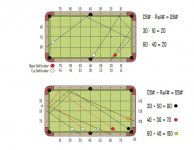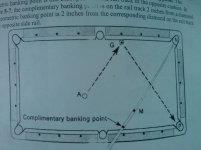Yo fellas,
I saw a Dr. Dave video on the Plus Diamond system for 2 rail kicks because I've been finding myself needing to 2 rail or 3 rail kick more and more as I play more so I needed to practice them.
Dave outlines the Plus Diamond system, which works as follows:

Shooting at the rail number shifts the kick that many diamonds up table. So, the OB is 3 diamonds away from the CB on the same rail, so aiming through the 3rd number (or 1st diamond on the rail to the right) will send the CB 3 diamonds left on a 2 rail kick.
But, the examples shown in his video only outline shots where the CB and the OB are almost perfectly lined up making it easy to count diamond distances.
How do you use this when the OB and CB are not on the same line, but are diagonal like so:

How do you find the 1st rail target position in this scenario?
I saw a Dr. Dave video on the Plus Diamond system for 2 rail kicks because I've been finding myself needing to 2 rail or 3 rail kick more and more as I play more so I needed to practice them.
Dave outlines the Plus Diamond system, which works as follows:

Shooting at the rail number shifts the kick that many diamonds up table. So, the OB is 3 diamonds away from the CB on the same rail, so aiming through the 3rd number (or 1st diamond on the rail to the right) will send the CB 3 diamonds left on a 2 rail kick.
But, the examples shown in his video only outline shots where the CB and the OB are almost perfectly lined up making it easy to count diamond distances.
How do you use this when the OB and CB are not on the same line, but are diagonal like so:

How do you find the 1st rail target position in this scenario?



